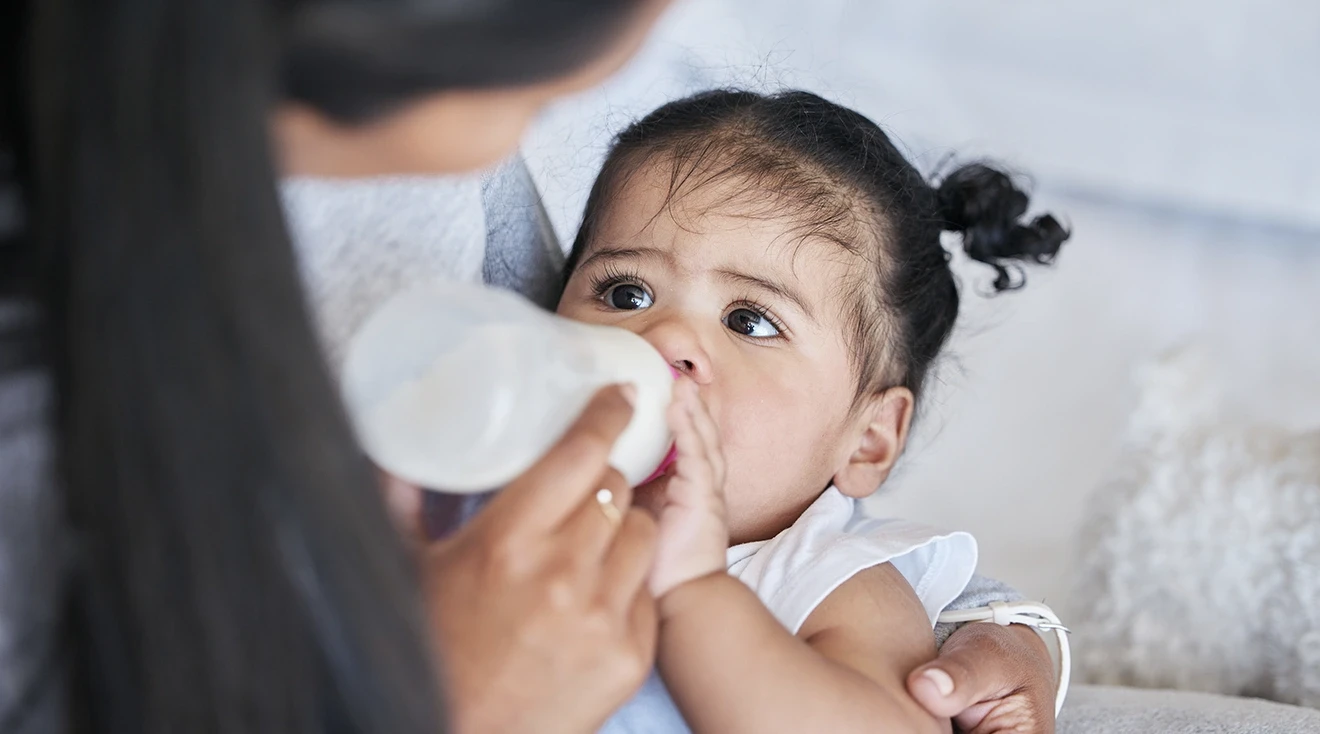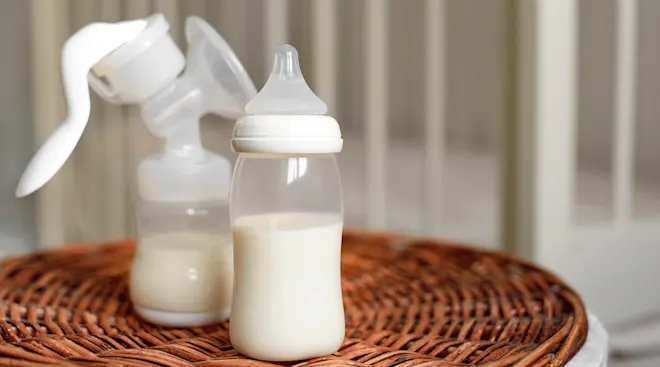Can You Mix Breast Milk and Formula?
Many new parents opt for combination-feeding (aka giving baby both breast milk and formula). It’s a great path for those who can’t exclusively breastfeed, but still want to give baby the benefits of breast milk. If this is you, you’ve likely considered mixing breast milk and formula in the same bottle. While this is generally safe, not all experts advise it. However, it’s still possible to safely mix breast milk and formula in baby’s diet. Read on for everything you need to know.
This is generally not advised. “Generally speaking, I’d keep them separate,” says Kathleen Kendall-Tackett, PhD, IBCLC, a health psychologist, clinical associate professor of pediatrics at Texas Tech University Health Sciences Center and author of Breastfeeding Doesn’t Need to Suck: How to Nurture Your Baby and Your Mental Health. If you choose to combination-feed, she suggests either feeding at the breast and topping off with formula as necessary, or alternating between breast milk and formula.
The Centers for Disease Control and Prevention (CDC) also advises separating the two: “If you feed your baby with both breast milk and powdered formula, breastfeed or feed your baby breast milk first, then feed the formula.”
Other experts say that mixing breast milk and formula in the same bottle is generally safe—be sure to check with your provider about your baby’s individual needs.
Some parents opt for feeding baby both breast milk and formula because they have low milk supply but still want to give their babies some breast milk. “Every bit is beneficial,” says Kendall-Tackett. If you exclusively breastfeed and want to start supplementing with formula—or eventually switch to formula altogether, mixing breast milk and formula could help baby with the transition. “Mixing can help babies get used to the taste and texture of formula,” says Jennifer Shu, MD, FAAP, a pediatrician with Children’s Medical Group, P.C. in Atlanta and co-author of Heading Home with Your Newborn. However, again, many experts don’t advise mixing breast milk and formula in the same bottle: Check with your pediatrician about what’s best for baby.
One downside of mixing breast milk and formula in the same bottle is that you might waste precious breast milk if you don’t use the full bottle before it goes bad, say both Kendall-Tackett and Shu. What’s more, you have to use up formula a lot quicker than breast milk. (A bottle of formula—alone or mixed with breast milk—is officially safe to keep in the fridge for 24 hours, versus breast milk alone, which can be refrigerated for up to four days, according to the CDC.
Additionally, adding formula into baby’s routine might mean you’re breastfeeding or pumping less, which can, in turn, decrease your supply, according to Kendall-Tackett.
The CDC advises breastfeeding or feeding baby with breast milk first, and then feeding baby the formula. But if your provider has given you the go-ahead to mix the two in the same bottle, “Mix the formula first as you normally would, then add some breast milk to the bottle,” says Shu.
If you’re using powder (or concentrated) formula, start by measuring formula and water as directed on the label, according to UPMC Health Beat. Then, prepare it according to the directions. Ready-to-use formula is, as the name suggests, ready to use straight out of the bottle.
Once you’ve prepped the formula, you can use it in any proportion to breast milk that works for you and baby. If baby’s trying formula for the first time, for example, you might want to add an ounce of formula to several ounces of breast milk. If, on the other hand, your baby is already used to the taste of formula, you may want to use mostly formula to stretch out precious pumped milk.
In general, experts advise keeping breast milk and formula separate. But if your provider recommends mixing breast milk and formula in the same bottle, there are a few things to keep in mind. First, temperature: It’s safe to serve mixed breast milk and formula cold, “but some babies don’t like it that way,” says Kendall-Tackett. If baby balks at cold milk, you might need to warm their bottle. Set the prepared bottle in a container of warm water or use a bottle warmer for several minutes. Avoid heating milk in the microwave, as it could result in hot spots that could burn baby’s mouth, says the CDC. Always test a few drops on your wrist before serving.
If baby is under 2 months old, born preterm or has a weakened immune system, you’ll need to take extra precautions to protect them from bacteria in powder formula, says the CDC. Boil the water you’re using to prepare the formula, add the powder formula about five minutes later and wait until the bottle has cooled before feeding baby.
When it comes to storing your mix of breast milk and formula, Kendall-Tackett says you can follow the guidelines for formula storage. The CDC and Food and Drug Administration (FDA) recommend refrigerating prepared formula for a maximum of 24 hours. The FDA also warns against storing formula in the freezer, as freezing may cause the ingredients to separate.
As long as baby hasn’t had a sip from a bottle containing a mix of formula and breast milk, you can keep the mixture in the fridge for 24 hours, as per the CDC’s guidelines for formula storage.
As soon as baby feeds from a bottle, the CDC says you’ll need to dump any unused milk within an hour: Bacteria can grow when formula combines with baby’s saliva.
When preparing powder or concentrated formula for baby, don’t use breast milk instead of water, says Kendall-Tackett. Formula already has more protein than breast milk, she explains, and adding breast milk without water could increase the concentration of protein and calories and potentially stress baby’s kidneys. Additionally, too little water in powder formula could cause baby to become dehydrated, according to the CDC.
Please note: The Bump and the materials and information it contains are not intended to, and do not constitute, medical or other health advice or diagnosis and should not be used as such. You should always consult with a qualified physician or health professional about your specific circumstances.
Plus, more from the Bump:
Kathleen Kendall-Tackett, PhD, IBCLC, is a health psychologist, clinical associate professor of pediatrics at Texas Tech University Health Sciences Center and author of Breastfeeding Doesn’t Need to Suck: How to Nurture Your Baby and Your Mental Health.
Jennifer Shu, MD, FAAP, is a pediatrician with Children’s Medical Group, P.C. in Atlanta and co-author of Heading Home with Your Newborn. She earned her medical degree at the Medical College of Virginia at Virginia Commonwealth University.
Breastfeeding Medicine, Infant Sleep and Night Feeding Patterns During Later Infancy: Association with Breastfeeding Frequency, Daytime Complementary Food Intake, and Infant Weight, June 2015
Nemours KidsHealth, Feeding Your Newborn, February 2021
La Leche League International, Mixing Milk
Centers for Disease Control and Prevention, How to Prepare and Store Powdered Infant Formula During an Emergency, June 2022
Centers for Disease Control and Prevention, Infant Formula Preparation and Storage, May 2023
Centers for Disease Control and Prevention, Proper Storage and Preparation of Breast Milk, January 2022
UPMC Health Beat, Can You Mix Formula and Breast Milk?, June 2023
U.S. Food and Drug Administration, Infant Formula: Safety Do’s and Don’ts, May 2023
Learn how we ensure the accuracy of our content through our editorial and medical review process.
Navigate forward to interact with the calendar and select a date. Press the question mark key to get the keyboard shortcuts for changing dates.




















































